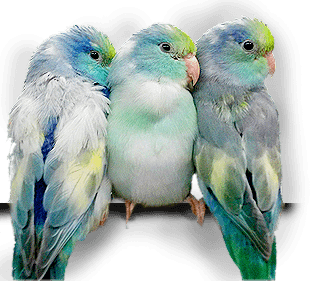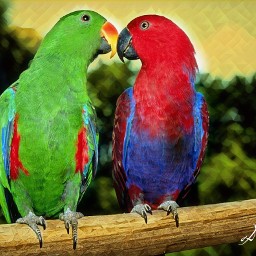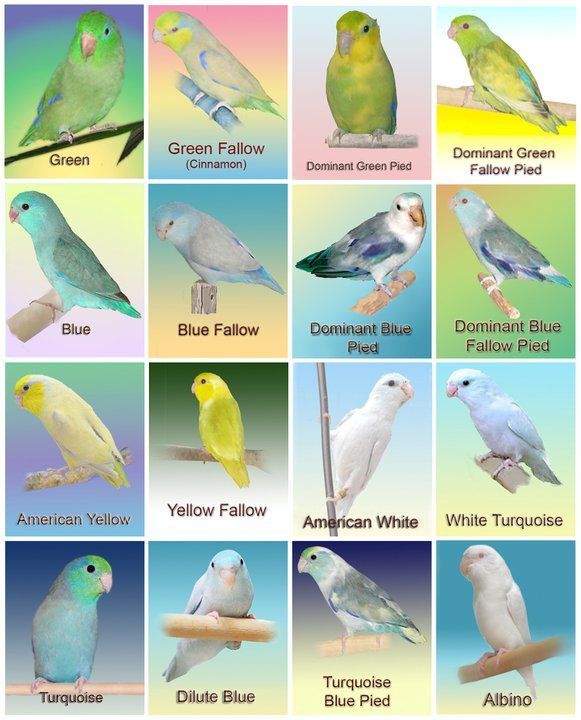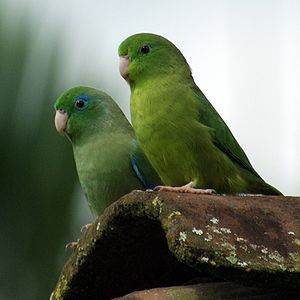| NOTE: The Aviary below is not associated with LuckyFeathers nor have they in any way endorsed LuckyFeathers. This is simply my personal review of this Aviary based on all the things I have learned and heard about them over the years from my own customers and from other breeders. |
|||||||||
|
My Breeder Reviews and Referrals |
|||||||||
|
|
|||||||||
|
The Parrotlet Ranch
|
|
Below is some information on the Parrotlet Book that I currently recommend to my customers |
| The Parrotlet Handbook By Sandee L. Molenda Published By: Barrons (Top) One of the best books written about Parrotlets. Below is a list of the Contents.The book is available on Amazon.com for around $10. I recommend anyone who wants a parrotlet or anyone who already has a parrotlet to buy this book. It is full of so much great information. See a preview of this book below – Click Here or to buy Table Of Contents Preface Chapter I – Meet the Parrotlet Introduction Parrotlets and their Special People History In Captivity What Are Parrotlets? Frequently Asked Questions Are There Differences in Personalities Between Subspecies? What is a Parrotlet’s Average Life Span? Chapter II – Parrotlet Identification (Top) Basic Classifications Identification Terms Pacific Parrotlets Color Mutation Parrotlets Pacific Color Mutation Descriptions Green Rumped Parrotlets Spectacled Parrotlets Rare Species Of Parrotlets Blue Winged Parrotlets Mexican Parrotlets Sclater’s Parrotlets Yellow Faced Parrotlets Chapter III – Choosing A Parrotlet (Top) Are You the Right Person for a Parrotlet? Considerations When Picking A Parrotlet Which Species? What Sex? One Parrotlet or More? Where to Buy a Parrotlet Purchasing from a Breeder Shipping Parrotlets Purchasing From a Pet Shop Bird Marts Purchasing Checklist Picking the Perfect Parrotlet Healthy Parrotlet Checklist Unweaned Parrotlets Tips For Purchasing Parrotlets Chapter IV – Housing The Parrotlet (Top) Cage Perches Food Dishes Watering Devices Mite Protectors Floor Covering Cage Location Covering the Cage Cleaning the Cage Finding Safe, Fun Toys Birdie Buddies™ and Happy Huts™ Mirrors “People” Toys Playpens and Baskets Other Equipment Air Filters Humidifier Scale Water Filter Chapter V – Feeding The Parrotlet (Top) Seeds Pellets Pellets and Color Mutation Parrotlets Other Necessary Foods Fresh Fruit For Your Parrotlet Fresh Vegetables and Greens – Fed Raw Unless Noted Organic and Homegrown Produce Legumes Nuts, Seeds, Legumes and Non-Animal Proteins Legumes and Other Non-Animal Proteins Animal Proteins Hot Cooked Diets Sprouted Seed Vitamins and Supplements Petamine™ Lory Powder Bee Pollen Spirulina™ and Wheat Grass Powder Cuttlebone and Mineral Blocks Mineral Blocks Grit and Oyster Shell Healthful Treats Healthful Recipes for Parrotlets Daily Fresh Food Mix Birdie Corn Muffins Brown Rice Recipe Basic Bird Bread Corn/Bean/Rice Recipe Parrotlet Ranch Beans Is Your Parrotlet Eating? Picky Eaters Wasteful Parrotlets Chapter VI – Bringing The Parrotlet Home (Top) New Home Checklist Cage Food Feeding Handling Stress New-Parrotlet Check Up New Bird Examination Procedure Leg Bands Patience and Understanding Quarantine Temperature Wings Chapter VII – Behavior and Training (Top) The Spoiled Parrotlet Parrotlet Behavior Cage Aggression Egg-Laying Pet Females Feather Mutilation Regurgitation The “Teenage Years” Training Basics The “No” Command The “Step Up” Command Playing “Ladders” Time Out Biting Teaching Parrotlets to Talk Pepper the Wonder Parrotlet Teaching The Parrotlet Tricks Fetch Get the Bell Night-Night Playing Dead Potty training Riding on a Toy Shaking Hands Standing on Head Chapter VIII – Grooming The Parrotlet (Top) Wing Clipping Toenails Beak Trimming Green Rumped Parrotlet Beak Problems Bathing Molting Preening and Pinfeathers Chapter IX – Breeding Parrotlets (Top) Housing Breeding Pairs Nutrition for Breeding Parrotlets Breeding Parrotlets Hand-Feeding and Socializing Weaning Parent-Raised Chicks Record Keeping Proper Equipment & Disinfection & Hygiene Hand Feeding Equipment Guide Color Mutation Parrotlets Pellet Diets and Color Mutation Parrotlets Breeding Parrotlet Mutations Inheritance Modes and Color Combinations Recessive Color Mutation Chart – Single Factor Recessive Color Mutation Chart – Combination Colors Chapter X – Traveling with Your Parrotlet (Top) Basic Travel Tips Car Traveling by Air Health Certificates Chapter XI – Hazards and Disaster Preparedness (Top) Around the House Airborne Toxins List of Common Household Airborne Toxins Cigarette Smoke Paint and Pesticides Stored Dangers Teflon™ and Other Non-Stick Surfaces Dangerous Foods The Avocado Controversy Houseplants Dangerous houseplants Safe Houseplants Over-Medication Other Birds and Animals People Toys and Cages Zinc and Lead Common Household Sources of Lead Disaster Preparedness Emergency Bird Supply Kit Chapter XII – Illness and Diseases (Top) Know What to Look For Signs of Illness Emergency Situations First Aid Bird First Aid Kit Hospital Cage Cuts and Abrasions Bleeding Feathers Broken Beak Tip Broken Toenail Shock Working With Your Veterinarian (Top) Holistic Medicine Bacteria Chlamydiosis (Psittacosis, Parrot Fever) E. coli Klebsiella Mycobacteria (Avian Tuberculosis) Mycoplasma Pasteurella Psuedomonas Salmonella Fungal Infections Aspergillosis Avian Gastric Yeast Candida Mycotoxins Parasites Ectoparasites Lice Mites Protozoal Parasites Cryptosporidium Giardia Microsporidium Viral Infections Beak and Feather Disease (P.B.F.D.) Herpesvirus Pacheco’s Disease Polyoma Virus To Vaccinate or Not? Pox Proventricular Dilatation Disease (P.D.D.) Further Education Books and Magazines Bird Clubs Online Death of a Parrotlet Necropsy Chapter XIII – Showing A Parrotlet (Top) What is a Bird Show? Societies and Specialty Clubs Great American and National Cage Bird Shows Other Benefits General Parrot Standards International Parrotlet Society Standards Preparing A Parrotlet For A Show Bands Conditioning Show Cages Show Cage Training Before the Show Night of the Show Attending the Show Divisions Show Tag and Registration Form Judging Procedure Accumulating Points Banquet and Raffles Chapter XIV – Beyond the Basics (Top) Further Information International Parrotlet Society Avicultural Organizations American Federation of Aviculture National Cage Bird Show Society of Parrot Breeders and Exhibitors Books Conservation Organizations American Bird Conservancy RARE Center for Tropical Conservation Magazines and Periodicals Bird Talk Magazine Parrot Life Veterinary References American Board of Veterinary Practitioners, Inc. ASPCA Animal Poison Control Center Association of Avian Veterinarians Chapter XV – Glossary of Terms Chapter XVI- Appendix Classifications of Forpus Parrotlets References Biography |
 Parrotlets for Sale
Parrotlets for Sale All Babies
All Babies Parrotel Live Video
Parrotel Live Video Lineolated Parakeets
Lineolated Parakeets English Budgies
English Budgies Parrotlet Color Mutations
Parrotlet Color Mutations Spectacled Parrotlets
Spectacled Parrotlets